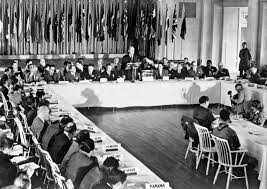In 1944, with World War II still raging, the world’s leaders knew one thing for sure: when the war ended, they couldn’t go back to the old financial system that had failed so badly before. The gold standard had collapsed in the chaos of war and depression, and no one wanted to repeat that disaster. But the big question was—what comes next?
So, in a quiet resort in Bretton Woods, New Hampshire, economists and politicians from 44 countries gathered to rebuild the world’s financial order from scratch. Their solution? A bold, never-before-attempted idea: gold is now tied to the U.S. dollar— and the U.S. dollar alone.
Instead of every country backing its money with gold, they would now peg their currencies to the U.S. dollar, because the dollar was backed by gold. This single decision shifted global financial power to America, transformed the dollar into the world’s dominant currency, and shaped the economic system we still live in today.
But was this new system stable, or just another ticking time bomb? Let’s dive into the story of how Bretton Woods created a new world order—and why it wouldn’t last forever.

Why Did the World Need a New Gold-Based System?
After 30 years of financial chaos, world leaders had learned some painful lessons:
❌ Lesson #1: The old gold standard was way too rigid.
- Countries needed the ability to adjust their economies during crises, but gold didn’t allow that.
❌ Lesson #2: No country could hoard all the gold.
- The U.S. and France stockpiled so much gold in the 1930s that other countries ran out, making the system collapse.
❌ Lesson #3: Countries needed a stable system for trade.
- After World War II, rebuilding Europe and Asia was the top priority. A reliable financial system was key to making that happen.
So, the goal at Bretton Woods was simple: Create a system that kept some of the stability of gold, but with enough flexibility to handle economic shocks.
The Big Idea: Gold Would Now Back Only One Currency—the U.S. Dollar
Instead of returning to every country backing its money with gold, the Bretton Woods plan proposed something radically different:
1. The U.S. Dollar Became the Center of the Global Financial System
- The U.S. had the largest gold reserves in the world (owning about 75% of the world’s gold by 1944).
- So, instead of backing every currency with gold, countries would peg their currencies to the U.S. dollar—because the dollar was backed by gold.
- 1 ounce of gold = $35, and that rate was fixed.
2. Exchange Rates Were Now Fixed—But Adjustable
- Countries agreed to keep their currencies stable against the U.S. dollar.
- If a country’s economy got into trouble, it could adjust its exchange rate slightly instead of suffering a full-blown crisis.
3. Two New Institutions Were Created to Manage the System
🏦 The International Monetary Fund (IMF) – Helped countries with short-term financial problems.
🏗 The World Bank – Provided loans to help countries rebuild after the war.
✅ Result: The world now had a new financial system that mixed gold, the U.S. dollar, and government oversight—something the old gold standard had never allowed.
Why Did This Give the U.S. So Much Power?
Here’s where things get really interesting…
By making the U.S. dollar the only currency directly tied to gold, the Bretton Woods system put America at the center of the global financial world.
- Countries had to hold U.S. dollars as reserves because the dollar was the next best thing to gold.
- The U.S. controlled the printing of the world’s reserve currency, meaning it could influence global finance like never before.
- The American economy was already the strongest after WWII, so this system cemented U.S. financial dominance for decades to come.
If you’ve ever wondered why the U.S. dollar is still the world’s most powerful currency today, this is where it all started.
The System Works… For a While (1944–1960s)
At first, Bretton Woods seemed like a success.
- The global economy boomed in the 1950s and 60s.
- Trade between countries increased like never before.
- The U.S. dollar was strong, and everyone trusted it because they could exchange it for gold at $35 per ounce.
But just like the old gold standard, this system had weaknesses—and they would eventually bring it down.
🔴 Problem #1: The U.S. Had to Keep Enough Gold to Back All the Dollars
- As global trade expanded, countries accumulated more and more U.S. dollars.
- But the U.S. didn’t have an unlimited supply of gold to back all those dollars.
🔴 Problem #2: The U.S. Started Printing More Dollars Than It Had Gold
- In the 1960s, the U.S. needed a lot of money to fund the Vietnam War and social programs.
- Instead of raising taxes, the government just printed more dollars.
- Other countries started getting nervous—if there were too many dollars and not enough gold, was the system still stable?
🔴 Problem #3: Countries Began Demanding Gold Instead of Dollars
- By the late 1960s, countries started asking the U.S. to exchange their dollars for gold, just like the system promised.
- The U.S. had printed too many dollars, so there wasn’t enough gold to cover all of them.
✅ Result: The system was now on shaky ground—and by the early 1970s, it would completely fall apart.
Conclusion: The Bretton Woods System Changed Everything
1️⃣ The world didn’t return to the old gold standard—but it didn’t abandon gold completely.
2️⃣ The U.S. dollar became the world’s reserve currency, giving America enormous financial power.
3️⃣ The system worked well for about 20 years, but printing too many dollars caused problems.
And just like the old gold standard before it, Bretton Woods was about to face its final crisis.
